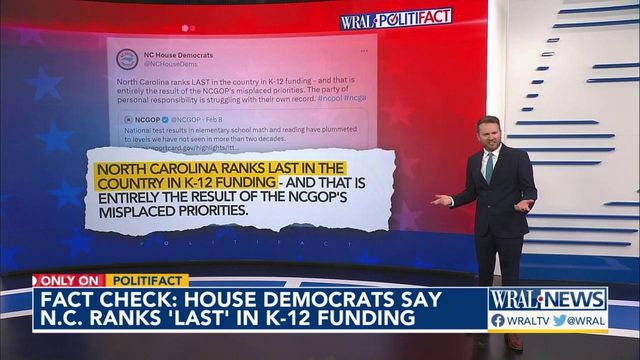Fact check: Does North Carolina rank 'last' in education funding?
For years, North Carolina Democrats have said that the state’s public schools are underfunded. Now, some are putting their claim into national context, saying the Tar Heel State is doing less for its students than every other state.
“North Carolina ranks last in the country in K-12 funding — and that is entirely the result of the [North Carolina Republican Party’s] misplaced priorities,” the Democrats in the North Carolina House of Representatives said on Twitter last month.
This tweet stood out because Democratic Gov. Roy Cooper signed the most recent state budget, saying it made “critical investments in education.”
The House Democrats’ tweet didn’t cite the source of its claim, so we reached out to the state Democratic caucus and the state Democratic Party. A party spokeswoman cited an article published by the Daily Tar Heel, “NC ranks last in national school funding effort, report says.”
The report was conducted by a credible education research group. However, the tweet leaves out key details. The national ranking pertained to North Carolina’s funding ability — not its spending levels alone. The ranking is also based on budget figures from three years ago, so it doesn’t provide insight into North Carolina’s current funding ability or funding level.
Funding level vs. Funding effort
The Education Law Center, a New Jersey research firm that advocates for more school funding, last year published its 2022 “Making the Grade" report about state spending on public school systems in the 2019-20 school year with a goal of assessing how “fairly” each state distributes funds across schools.
Looking at every state and Washington, D.C., the center ranks each state in three categories: funding level, funding distribution, and funding effort. While North Carolina is ranked last in funding effort, the state isn’t ranked last in funding level or funding distribution. Here’s how the group defined those terms:
- Funding level, also known as per-pupil spending. This is a common way of measuring education funding. The Education Law Center, in this case, ranks states by dividing their state and local revenues by student enrollment. It excludes most federal funding, as well as district-level payments to charter schools, private schools, and other school systems that are reported as expenditures. The center then adjusts the resulting numbers for regional differences using the National Center for Education Statistics’ Comparable Wage Index for teachers. In this category, North Carolina ranked 48th, ahead of Idaho, Utah and Arizona.
- Funding distribution. This measure was designed to assess how well a state’s additional funds are distributed to school districts with high levels of student poverty. In this category, North Carolina came in 19th.
- Funding effort. This category looks at public pre-K to 12th grade funding as a percentage of the state’s gross domestic product. By this measure, North Carolina came in dead last, spending 2.32% of its GDP on education.
The state’s funding of education is not tied to growth in its GDP. Nonetheless, the Education Law Center said it believes the comparison is fair because it shows the state’s capacity to raise funds, according to Danielle Farrie, the center’s research director.
The North Carolina Department of Public Instruction, however, says North Carolina’s education system shouldn’t be judged by one group’s measurement of funding effort. The department, which oversees the state’s public schools, isn’t aware of any research identifying the “ideal” percentage of GDP expenditures for education, DPI spokeswoman Blair Rhoades said in an email.
The U.S. Department of Education tracks student scores in math, reading, writing and science at grades 4, 8 and 12. The Education Law Center gave academically high-achieving Massachusetts low funding effort scores Meanwhile, West Virginia, one of the nation’s lowest academic performers,was ranked 6th for funding effort.
Farrie said the Education Law Center’s funding effort grades are not indicative of the quality of a state’s education system. They are designed to show the capacity of the state to raise more revenue for schools, she said.
The relevant difference between North Carolina and Massachusetts is this, Farrie said in an email: Both might get an “F” for effort, but Massachusetts has per-pupil funding levels well above the national average, while North Carolina has levels well below the national average. “Massachusetts is a very wealthy state and is able to generate high funding levels with little effort,” she said.
Outdated information
The data is also outdated. The Education Law Center has yet to analyze state education budgets for the school years since 2019-20, Farrie said.
It’s impossible to predict how those budgets will affect North Carolina’s ranking, Farrie said. The group doesn’t expect to produce its report on 2020-21 education funding until later this year, she said.
“Everything is relative,” Farrie said in her email. “NC will have had to improve relative to other states. And with the effort measure, their ranking is also dependent on how the state’s GDP changed. So we just have to wait for the data to see where they fall.”
Other rankings put North Carolina low but not last
In the meantime, other groups have crunched state budget numbers from more recent years.
For the 2020-21 school year, the National Education Association ranked North Carolina 41st for public school expenditures per student. Reports from the Urban Institute, and EducationData.org cite data showing that North Carolina’s recent per-pupil funding levels for K-12 education have been lower than many states — but not the lowest.
Researchers who last year compiled the report, “The Adequacy and Fairness Of State School Finance Systems,” also looked at each state’s “fiscal effort” for K-12 education in the 2019-20 school year. They ranked North Carolina 46th.
Bruce Baker, one of the report’s authors, chairs Miami University’s Department of Teaching and Learning. He said North Carolina isn’t usually ranked last in education funding.
“On most measures — and in my general opinion based on the indicators I've developed over the years, Arizona owns that spot,” Baker said in an email. “North Carolina has tried hard to get there and is part of the race to the bottom. But I don't think they are last in many lists.”
Amanda Eubanks, director of the North Carolina Democratic Party’s House Caucus, said it’s clear that state Republicans have failed to properly invest in public schools.
“Their under-investment has left families and kids across our state to bear the brunt of teacher shortages and under-resourced schools and hurt the potential of our future leaders and workforce,” she said in a statement.
Our ruling

The North Carolina House Democrats’ Twitter account said the state “ranks last in the country in K-12 funding.”
The party said this claim is based on a study of 2019-20 education budgets from across the nation. But the tweet omits key context: that it’s referencing what one organization calculated to be North Carolina’s “funding effort” — its public pre-K to 12th grade funding as a percentage of the state’s GDP — not its funding level.
The same organization ranked North Carolina 19th for how well it distributed funding to schools with high student poverty and 48th for its overall per-pupil spending. Other measures, including the National Education Association, the Urban Institute and EducationData.org have ranked North Carolina low on its per-pupil funding, but not dead last.
The statement contains an element of truth but ignores critical facts that would give a different impression. That’s our definition of Mostly False.













